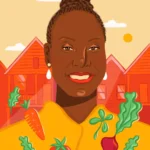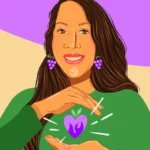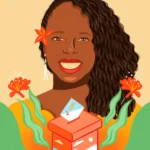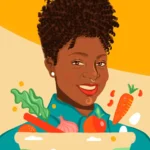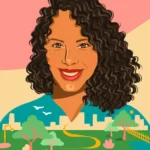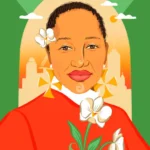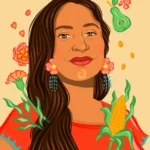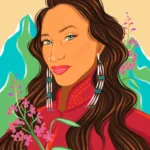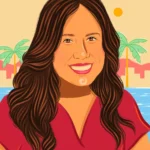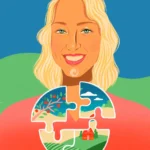Wisdom on Leadership + Community Organizing
When asked to reflect on the way that they approach leadership, Climate Resilience contributors resoundingly responded that they aim to empower community members to lead the way:
“A big part of my work, on a very personal level, is just to uplift people around me and affirm them in how brilliant they are and how they matter and their perspectives matter. I’ve done a lot of that kind of leading from behind and being a support person so others can feel comfortable.”
Kailea Loften![Illustration of Kailea Frederick]()
“I think people can lead themselves. I think I’ve casted a space where people can show up fully and be themselves. That’s my aim.”
Jacqueline Thanh![Illustration of Jacqueline Thanh]()
“I think you have to be collaborative and lead with relationship, where leadership can be felt and embodied in a different way. At a lot of places I’ve worked, where things have been more hierarchical, it’s really easy to get stuck up here in the vision when you’re not dealing with the administrative and operational pieces, so holding a little bit of everything is a really great way to be a leader because you know what it takes to pull something off, and you can still hold vision rather than getting stuck in the mire of the task list. So finding that balance of getting things done, holding things done, and being in relationship.”
Deseree Fontenot![Illustration of Deseree Fontenot]()
“I believe in servant leadership, that my boss is the community, not the board.”
Janelle St. John![Illustration of Janelle St. John]()
“I don’t think you can really lead people if you don’t believe they already have everything they need to organize and lead themselves. I think if you lead people through the belief that you have all of the expertise and knowledge and your job is to teach other people what you have and what you know, you’re going to fall short. It’s actually about unlocking other people’s expertise and wisdom, because their lived experience is their power.”
Mariela Ventura![Illustration of Mara Ventura]()
“My leadership style is Afrofuturist, collaborative (in the sense that I see being a leader as both teacher and student at the same time, and vice versa for the folks I’m in community with), joyful (I like to laugh, smile, and have fun), and based on the development of others into leaders.”
Dominique Thomas![Illustration of Dominique Thomas]()
When asked to expand on how they approach their organizing work to be as just and inclusive as possible, Climate Resilience contributors responded:
Let those most impacted lead
“My philosophy is that folks who are most impacted by climate and environmental issues, that are most frontline to the issues, have the most wisdom on the issues. So, with that, my starting point is within communities of color and low income communities. Once you’re in that space and working in those communities, there are so many leaders that are doing phenomenal work- mostly women- and who are doing the work in some of the most effective ways. Those are the folks that I spend time with and that I’ve chosen to work with and support because I know that if they succeed, we’re all successful.”
Sekita Grant![Illustration of Sekita Grant]()
“Centering the voices of those that are most impacted is embedded into our organization. For example, our staff are all Black, Indigenous, and other people of color. The majority of our Board of Directors are people of color. Almost all of our staff live within walking distance from our students. We’re also a predominantly queer organization. So, it’s not something that we have to learn to think about.”
Lil Milagro Henriquez![Illustration of Lil Milagro Henriquez]()
“My theory of change is that the people most affected by a problem have the solutions and certainly should have a seat at the table to create those solutions. It’s the model that I live by. When you have that lens, you make sure you’re talking to the folks most impacted. I’m also a directly impacted person. It helps to be of those communities so that I’m not parachuting in. Even not growing up in Louisville, and having the privilege of earning a masters degree, I’m very cognizant of that and I make sure to share resources and contacts and to build with folks who are more affected than myself.”
Cassia Herron![Illustration of Cassia Herron]()
“It’s incredibly important that, when the opportunity arises for changes in the built environment, residents are in the driver’s seat and get to drive all aspects of that decision. Really frequently, however, they’re not even allowed in the car when we’re talking about decision-making at the local level. What it means to be people-centered, functionally and actively, is that folks have the choice. Do you even want this in your community? And second of all, what specifically do you want? And third, we make sure that residents have the ability to stop the project if it ends up not quite matching their vision, so the reins of power are firmly in the hands of the residents. If we think about residents tokenistically participating, that might look like translating a flyer for an event at 10 am on a Tuesday. Instead, this is a scenario where residents are leading the process, they’re paid to organize, to knock on doors, etc. It varies so much from project to project but what stays consistent is that residents are in the driver’s seat.”
Cate Mingoya-LaFortune![Illustration of Cate Mingoya LaFortune]()
Ensure that nobody is left out
“From the very first or second meeting we ever had, I was asking, Where are the young people? … If we actually want to be honest about what we’re going to be dealing with and facing, we need young people at the table because they’re not politically driven and they have strong moral compasses; they’re not afraid to stick with the truth and the real timelines of what we’re dealing with.”
Kailea Loften![Illustration of Kailea Frederick]()
“I ask myself, who’s being left out, and who are my people? Everybody is my people, but I also know that there are some people who are my people and have been left out, and I have a specific responsibility to make sure that they are included.”
Mariama White-Hammond![Illustration of Reverend Mariama White Hammond]()
“There are two questions that I think are always powerful to ask; who benefits from this and who doesn’t? You can ask that question when you’re in a room and there are solutions or projects being proposed. And who’s not in this room right now? And how can I speak up to bring those voices forward, or how can I break down some walls and barriers to ensure that the people who need to be here to hear about these things and speak up about these things can get there? That’s largely informed my work and partially explains why a lot of my work is just basic translation.”
Niria Alicia![Illustration of Niria Alicia]()
Meet community where they’re at
“I constantly think about who we are doing this work for, who is contributing to this work, who else we can call into this work, who’s dictating the work in the first place, and what we’re working towards… Our approach isn’t Hey, come to listen to us. Instead, it’s Hey, can we listen to you?”
Ruth Miller![Illustration of Ruth Miller]()
“You never want to balloon in. Find the voices there. Support them to do their work and give them resources and step away.”
Irfana Jetha Noorani![Illustration of Irfana Jetha Noorani]()
“My team and I focus on meeting the community where they naturally gather and tailoring the outreach to the community members. All of our materials are bilingual. If we have food at the workshops, we hire local food vendors. If we’re hosting a workshop for kids, we work with a community art center to lead the activity. In every instance, we’re trying to meet the community where they’re at and relate the issues to what they’re concerned about. The goal is to uplift the expertise in the community. I’m really just a stakeholder engagement coordinator or a community liaison; the folks that I’m working with are really the experts of the things going on in their community."
Natalie Hernandez![Illustration of Natalie Fernandez]()
Build trust and authentic relationships
“We need to be intentional about building relationships with historically marginalized communities with awareness, focus, love, and attention. We also need to go at the speed of trust, which makes this a really long game. For decades, communities of color were ignored or an afterthought in modern American environmentalism. After so many years of not being prioritized, there’s distrust. So, we need to go slow. A lot of the work is invisible; it looks like attending community meetings, contributing ideas, and consistently showing up.”
Olivia Juarez![Illustration of Olivia Juarez]()
“Show up places with pie. Bring pie and make friends. I am literally in the process of baking a pie right now. I feel like that’s a huge part of this- showing up in other peoples’ spaces. If you want people to be part of your thing, you can’t just expect that they’re going to have any interest or time. But if you go to other peoples’ things and form relationships, and not with a specific agenda other than I am interested in you as a human, I think that makes a huge difference in all of this work. It’s relationship-building more than anything.”
Mindy Blank![Illustration of Mindy Blank]()
“Community organizing is mostly building relationships. Obviously there would be no community without the people in it. That’s what it’s made of. The very basis of my work is making phone calls and writing emails and meeting people over webinars and trying to follow up with them and hosting community education opportunities where we can all learn together. I ask people, how are you doing, what are you seeing in your community, what are your opinions? That’s a key step. It takes a lot of time and it’s a lot of hard conversations but you can’t skip it. It’s so important to build that trust.”
Kavaangsaar Afcan![Illustration of Kavaangsaar Afcan]()



